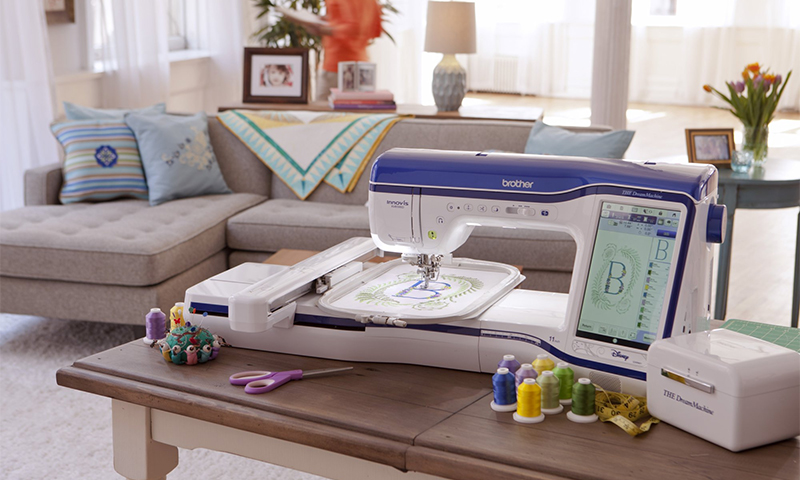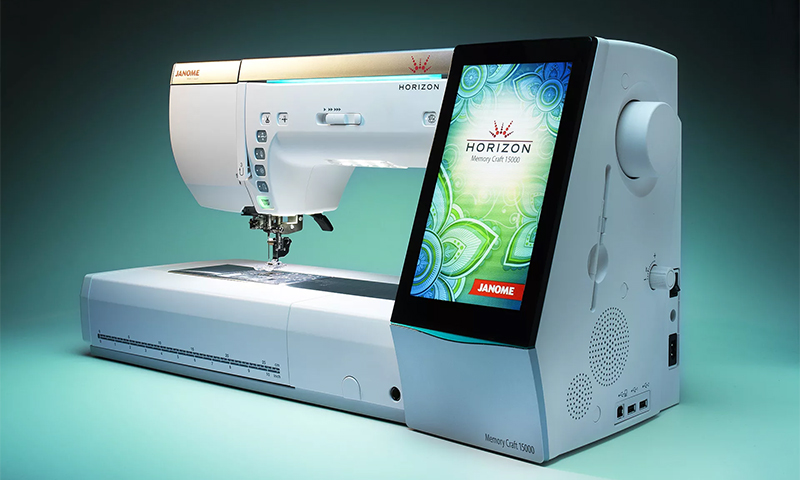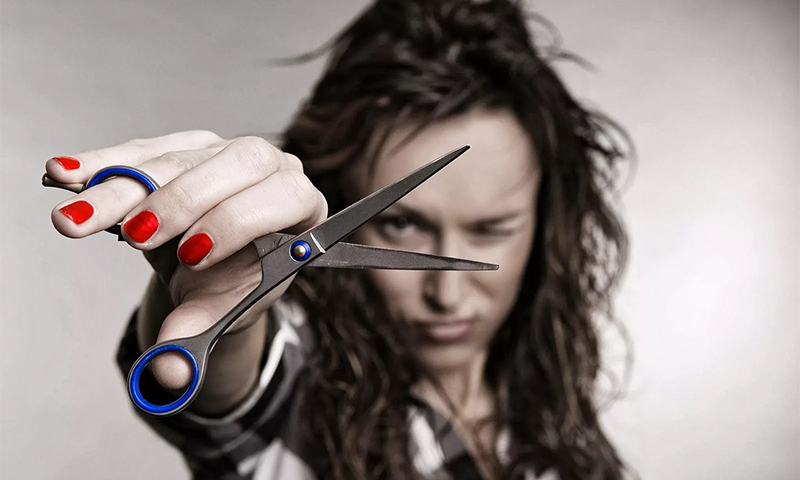Handmade today in fashion: handmade dolls, embroidered tablecloths and napkins, exclusive custom-made clothing - all these things are made by hand by a craftsman. But in the sewing business there are a lot of moments when it is necessary to bring highly specialized equipment to work - for example, to sweep over the edges and protect the fabric from shedding. This is where overlock comes in handy, thanks to which any thing will get a neat look and last longer.

Content:
The best manufacturers of overlockers - which company to choose
Before buying a sewing machine, first of all contact the manufacturers who have already proven themselves in the market. Their models are highly reliable, do not allow marriage in work and often have impressive functionality.
Quality overlocks are offered by well-known companies:
1. Janome
2. Brother
3. Pfaff
4. Juki
5. Bernina
In their lines you can find both budgetary and expensive professional models - the best of them are represented in our rating.
And how to choose a reliable and practical overlock for specific tasks, we will tell further.
The principle of operation and the device overlock

Overlock is significantly different from a sewing machine, although these two units have quite a lot of common nodes and elements. Still, he has a narrow specialization and is intended exclusively for processing edges: trimming and overcasting.
Overcasting machine is a compact body with a working surface, where, in addition to the needle (or several), there are also knives for cutting fabric.
In addition, the design includes other elements:
1. Thread holder with tensioners manual or automatic adjustment.
2. The loopers, interlacing threads during the movement of the needle - it is on their work that the quality and type of overcoat seams depend.
3. A flywheel that triggers all overlock mechanisms.
4. Conveyor - in its construction it differs little from that installed in the sewing machine, but without effort it stretches even elastic knitted fabrics without deforming them.
5. Removable converter - used to work with very thin fabrics that are overlapped with double-stitched seam. It is installed on the upper looper and can be switched off if necessary.
To start working with overlock, you need to correctly thread the threads from each coil, then set the type of seam on the control panel and you can proceed to overlaying. The smart machine will perform all the operations on its own: cut the disheveled edge and immediately seize it with a multi-thread seam so that the fabric does not crumble and disband.
Types of overlockers
Overcasting machine (overlock itself)
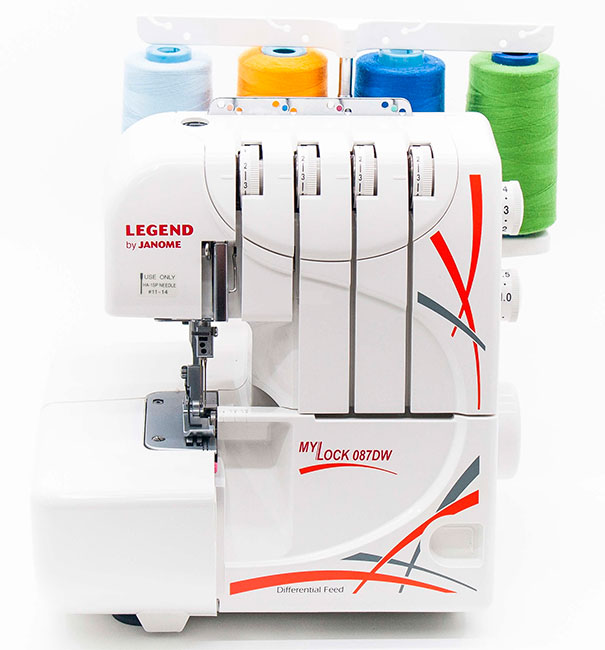
Compact technique that allows you to cut the fabric blank and reliably sweep over its edge. It is a must-have addition to a regular sewing machine for those who sew a lot.
Overlocks can differ in the number of threads used during operation. Standard models can hold from 2 to 5 bobbins - the variety, quality and reliability of stitches depend on their number. Overcasting machines are used to handle knitwear, satin, silk, cotton, wool fabrics. Some models are able to sweep thick edges of carpets and carpets.
Overlock for home use can work at speeds up to 1500 stitches per minute - that’s enough for any experienced seamstress.
Pros:
- Small size and average weight (5-12 kg);
- Stretch strings stretching in two directions;
- The abundance of adjustments (the gap under the foot, the speed of drawing the fabric, the tension and feed threads);
- Many models are completed with an additional hose platform;
- Ability to turn off the blades;
- Highlighting the work surface.
Minuses:
- Complex refueling system;
- Models with manual tuning require a lot of experience;
- High demands on the quality of threads.
Coverlock

This is a hybrid that combines the functions of a traditional overlock and a spreading machine in one case. That is, he not only sweeps over the edges, but also heaves them with a hem, and even grinds together the individual parts of the product with a flat seam. In addition, koverlok know how to make decorative, combined and elastic chain stitches.
The departure of the sleeve at the carpet cover is longer than that of the overcasting machine, since it must work not only at the edge of the product. But the speed is slightly more modest - usually no more than 1300 stitches per minute.
Pros:
- Functional over normal overlock;
- Copes well with dense and rigid tissues;
- Able to make decorative seams and grind parts together;
- It has a rich complete set (extra pads, stops, screwdrivers, needles, thread-threaders, etc.).
Minuses:
- Not all models have a hose platform;
- Tricky refueling;
- Large thread consumption.
Overlock options

Loopers
Unlike the sewing machine, there is no shuttle in the overlock - here its functions are performed by loopers.
The number of loopers and design features determine how many types of seams will be at your disposal, and what quality they will be:
1. Budget overlocks (they are also called flatlocks) are equipped with just a pair of loopers - upper and lower. Accordingly, they simultaneously work only with two cords. This is quite enough to cover thin fabrics or knitwear, but nothing more can be expected from these machines.
2. Three-strand loopers are installed on overcasting machines of the average price category. This is the most common option, allowing you to create reliable seams on crumbling fabrics and opening knitwear. If you loosen the needle thread and tighten the lower looper, you can also get a flat Flatlock seam on a three-thread.
3. The four thread looper has even more features. It is suitable for stitching parts with simultaneous overcasting and “knows” at least 7 types of different seams. Such loopers are installed on the coverlocks.
4. Five-thread - are a system of three lower and two upper loopers and provide the largest line width.
5. The chain stitch looper is an additional lower tab that allows you to create reliable and neat seams that stretch in the longitudinal direction. Such chains can be seen on T-shirts, T-shirts, pajamas, belts and children's clothes.
With an increase in the number of worker threads (and, accordingly, loopers), the cost of the overlock also increases, so choose a model according to your needs, without chasing excess functionality. Also, when buying, pay attention to the availability of loopers, because you have to regularly refill each thread in them.
Power
This indicator is usually tied to the overlock functionality: the more different operations it “knows”, the higher the power consumption of the machine should be:
- For low-cost two-and three-pole devices, 75-100 W power is sufficient;
- Overlocks working with 4-5 coils should consume 100-220 W;
- Professional multifunction models can be equipped with an engine of 250 W and above.
Refueling method
Threading in the overlock is even more difficult than in a sewing machine, and for a beginner this is a real hell. Of course, all models are accompanied by detailed instructions, where the filling scheme is painted and illustrated literally in steps, but this work is still a long and dreary job. It is especially difficult to wind the threads in the lower loopers.
Manufacturers offer various types of complete tankers, designed to simplify and speed up the process of preparing for work:
1. Mechanical - set in models of the average price category and some budget devices.
2. Pneumatic - literally suck the cord through special air channels, but seriously increase the overlock cost and at first require a little practice.
Type of tension adjustment
Thread tension plays an important role in the creation of complex overlaying seams and directly affects their quality.
Manufacturers propose to regulate it in three different ways:
1. Manually on the front panel using separate tensioners for each coil. This option is suitable for experienced seamstresses, because the wrong setting can lead to thread breakage.
2. With the help of tensioners located on the same axis. In this case, all working threads stretch the same way, which allows to obtain high quality seams and reduces the risk of breaks, but limits the possibility of experiments with stitches.
3. Computer controller - used in expensive models, where the microprocessor itself monitors all operations, including supports the correct tension in accordance with a given program. But experienced masters can fine-tune manually.
Stitch characteristics
The basic stitch indicators even in the simplest overlocks can be adjusted, but when choosing, you need to pay attention to the limit values in order to determine the limits of the machine's capabilities:
1. Stitch width
The minimum width in modern overlocks varies within 1-5 mm, the maximum - from 3 to 16. The wider the stitch the machine can make, the more opportunities you have for creating beautiful decorative stitches and zigzags. But this is important only for the coverlocks, and overcasting devices have enough average indicators.
2. Stitch length
The characteristics usually indicate the minimum value in the range from 1 to 3 mm. If your overlock can do very short stitches just a millimeter long, you can achieve high strength of the finished seams.
Presser foot adjustment
This function is in all overlock models. It allows you to set the required distance between the working surface and the fabric, depending on the thickness and stiffness of the latter.
You need to choose the maximum height of the presser foot:
1. For work with knitwear and regular fabrics, 4-7 mm is enough.
2. In kovorlokah this value can increase to 14 mm, since they often work with fabrics, folded twice, and even tripled.
3. In overcasting machines intended for processing carpets, the foot should rise to a height of 2.5 cm.
In any case, preference should be given to models with a smooth, rather than a stepped adjustment of the clamp.
Accessories and functions
The richer the functionality and equipment of the overlock, the more expensive it will be to buy it, but it will be much more convenient to use the machine:
1. The presence of a hose platform is simply necessary when working with narrow details: cuffs, trousers, etc. Of course, you can adapt to its absence, but it will be much easier to cover it.
2. Execution of a role seam - this option will allow you to work with very thin fabrics like tulle and chiffon, not just sweeping over the hem, but pre-twisting it into a thin rulik.
3. To trim excess fabric and trim the edges, knives are used, located at the top and bottom. Usually overlocks are lower-wheel drive, which allows you to disable the upper blade, in models with upper drive, respectively, the lower one is removed. In the second case, the pruning process is easier to control.
4. Differential conveyor - allows you to set different speeds of movement of the front and rear combs for pulling fabric. With it, you can make beautiful gathered edges right in the process of paving.
5. For better visibility of the working area, overlock devices are equipped with backlight. In cheap models there can be installed not too bright incandescent lamps, and in expensive and sophisticated ones there are more efficient LEDs.
6. Manufacturers also complement good overcasting machines with a cover, spare pads, needles, coils, holders, brushes and nipples to take care of the mechanisms.The presence of all this small things does not affect the work of the overlock, but to some extent confirms its quality and serious approach of the manufacturer.
Which overlock to choose
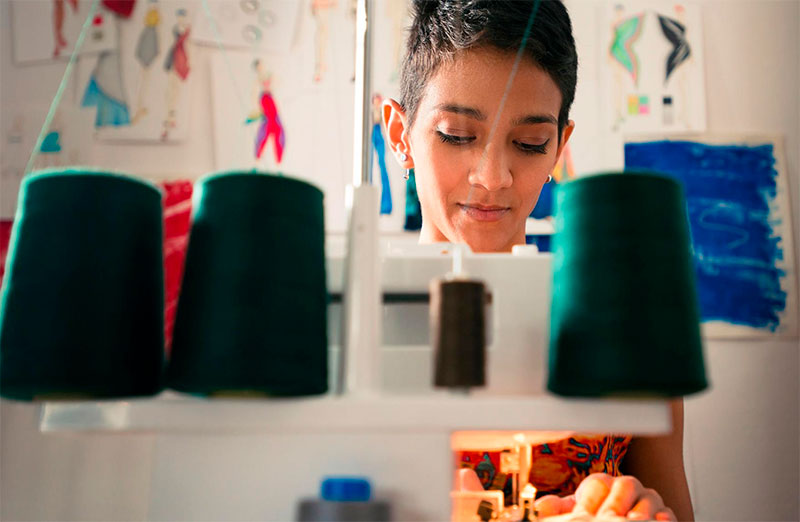
1. For a novice seamstress, who has not yet fully figured out all the intricacies of his work, an overlock with three threads and adjustment of tensioners on one axis will do. These models will provide a sufficient number of different stitches and will not cause much trouble in the work. The main thing that the engine power was not lower than 100 watts.
2. If you want to make money on needlework or are engaged in sewing and repairing clothes, buy an overlock with three or four thread loopers and a removable tubular platform. The presence of a differential conveyor and a minicomputer that will monitor the execution of various programs is welcomed.
3. For experienced craftsmen, it is better to purchase a carpetlock with 4 or 5-thread loopers and a total power of at least 220 watts. Not to be superfluous here will be a pneumatic tanker, a computer thread tension regulator, and a stitch width control function.
How much are overlock
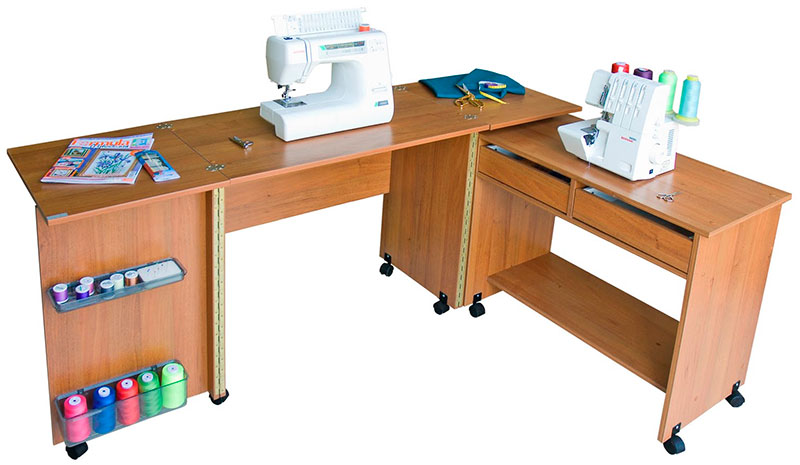
The cost of overlock depends on the availability of additional functions. Budget options may please low prices, but the work will show itself is not the best way. The desire to save will result in daily hassle of threading and setting up tensioners, as a result you will spend a lot of time preparing.
Prices for models vary as follows:
1. Overlock with two threads and automatic dressing can cost from 4 500 to 15 000 rubles. Nevertheless, it is undesirable to take a machine cheaper than 6 thousand - the quality of its work will not please you.
2. An "amateur" three-thread overlock with five types of stitches will cost from 4,000 to 13,000 rubles. Here, too, do not chase the frankly cheap - set for yourself the threshold of reasonable savings at the level of 7-8 thousand.
3. Semi-professional models for 3-4 threads, capable of performing at least 7 types of stitches will cost you in the amount of 12 to 28 thousand rubles.
4. Professional coverlock with 5 threads, smooth adjustment of the foot and automatic tension of the cords will pull on 21-39 thousand. For a more advanced model, "knowing" at least 2 dozen lines and equipped with a pneumatic tanker, you will have to pay 45-75 thousand rubles.
It will be interesting to friends too



